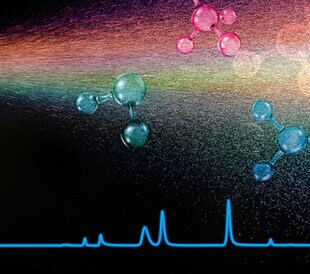If you are looking for a quick solution checklist to help you find peak resolution, search no further. This guide explains how focusing on each step in your analysis will help you achieve better peak resolution.

Baseline resolution of peaks (where your detector trace returns to baseline between the peaks) is the goal for every high-performance liquid chromatography (HPLC) analysis. That’s because having enough resolution between peak pairs ensures you can accurately identify and quickly quantify all analytes in your sample.
Non-baseline resolution — or co-elution of peaks — is caused by increases in peak tailing, changes in selectivity, and poor sensitivity. This limitation impacts your ability to review data quickly AND introduces variability in your analysis. So, you can see why optimizing the resolution of your analysis is a major data quality boost.
Figuring out how to optimize the resolution of your HPLC experiment can be a daunting task. There is always the first feeling of, “Where do I even begin?” That’s where this guide can help.
Some ways to improve resolution are to adopt new column chemistries and employ modern instruments and software technologies, but if you don’t have the option of upgrading your technology, there’s likely a handful of things you can change in your current workflow to improve peak resolution.
Keep in mind, you need to create a systematic approach once you begin your analysis, changing only one parameter at a time while keeping the others consistent to determine the effectiveness of each step.
From sample preparation to data collection, here’s a detailed checklist of things you can tweak to maximize your peak resolution.
1. Sample and system preparation
□ Sample preparation
The first step of every HPLC analysis starts with sample preparation. Proper filtration or extraction based on your application and system requirements that remove particulates and impurities will improve your resolution.
□ Sample container
For your light-sensitive analytes, prevent analyte degradation by selecting the proper actinic vial. Analytes that are hydrophobic/hydrophilic might require you to select a container that prevents unwanted binding to the surface of the container.
□ Mobile phase composition
Your mobile phase composition is critical and can have a significant impact on analyte retention and selectivity. Things like aqueous/organic solvent ratio, mobile phase pH, and buffer ionic strength all impact resolution. Solvent composition can completely change your separation science. You can refer to Methods for Changing Peak Resolution in HPLC: Advantages and Limitations for more in-depth theoretical analysis.

Differences in mobile phase pH and buffer concentration running the same analytes
□ Column selection
Equally as critical as the mobile phase consideration, your column stationary phase is important to think about when optimizing your resolution. Consider using smaller particle sizes and solid-core particles, which can further increase resolution by increasing efficiency. Longer columns generally mean smaller particles and larger pores. This improves peak resolution but increases back pressure and analysis time.
2. Pump
□ Flow rate
You have loaded your samples and mobile phase, and installed your column. When you click your system on, the first parameter that’s going to affect resolution is your flow rate. It’s important to find the optimal flow rate that maximizes peak efficiency with overall run time.
In most cases, lowering the flow rate will decrease the retention factor at the column outlet, making all peaks narrower and giving a better response factor. Increasing the flow rate can cause peaks to widen, decreasing the resolution – but will shorten run time.
Columns packed with smaller particles and/or solid-core particles provide further benefits in maintaining high peak resolution at faster flow rates.
3. Autosampler
At this point, your pump is on and the solvent is flowing through your system. Once equilibration is reached (flow rate is filling all of the flow path) it is time for the fun part — sample injection.
□ Injection volume
The injection volume parameters that will alter your resolution are sample concentration, column capacity and detector sensitivity. In most cases, the more sample you inject into a column, the more peaks begin to front. Retention time may decrease and negatively impact column efficiency and resolution. This factor is known as mass overload.
Overloading your column with too much sample will also max out the detector limits and cause other non-ideal scenarios. As a rule of thumb, you should inject 1-2% of the total column volume (for sample concentrations of 1µg/µl).
4. Column compartment
From the pump, to autosampler, your next stop on the optimization express train is the column compartment. Although we’ve accounted for column chemistry, you’ll also want to ensure that column size, length, and conditions of the column are responding as hypothesized.
□ Column temperature
The temperature of your column compartment plays a big role in separation efficiency and selectivity.
Higher temperatures allow a faster flow rate and quicker analysis, but on the flip side, can cause sample degradation and lower resolution. Lower column temperatures will allow higher retention, improving peak resolution. However, the analysis will be slower.
Make sure you know the temperature limits for your sample, solvent, column and instrumentation, and slowly tweak the parameters within these guidelines.

Stacked chromatograms of the same model sample separation at different temperatures.
□ System backpressure
When flowing mobile phase through the column/HPLC system, you will notice a certain pressure is generated. This term is often called system backpressure. Noting the system backpressure is a useful tool for optimization, especially as your column and instrument ages. Increasing or excessive back pressure are clues that could mean clogging or column degradation. Proper maintenance, cleaning, and/or replacing the column can return your system to optimal use. Always refer to the column manufacturer’s recommended procedures and guides for optimal column maintenance and cleaning techniques.
5. Detector
The detector is the last stop on your sample’s journey. Before you begin optimizing your detector’s settings, consider if you have even selected the correct detector for the job. Variable wavelength, diode-array, charged aerosol, refractive Index, fluorescence, single quadrupole mass spectrometers … the list goes on. Make sure you select the detector you need based on analyte properties, sensitivity, range and more.
□ Detector settings
Once you’ve determined the optimal detector for your analysis, it’s time to make sure that resolution is up to par. Major parameters that you must consider are:
- Wavelength: When using UV-Vis detectors, wavelength should be the first parameter to optimize. By evaluating the absorption spectrum of the analyte(s) of interest, you can find the most optimal wavelength to give the highest absorption. This technique minimizes interference and provides higher sensitivity.
- Response time: The general rule of thumb is you should set the response time to one-third of the peak width at half the height of the narrowest peak of interest. (That sentence may require you to read it over a few times or get out a pen and paper.)
- Data acquisition: Too few data points can affect your peak shape, reproducibility, and area precision. At a minimum of 20 — but ideally 30-40 — data points per peak is required for optimal peak resolution.

And don’t forget to care for your HPLC system!
Optimizing the resolution of your instrument or method can be a time-consuming process, but it is an important part of any analysis and will help you grow more in tune with your instrument. Once you’ve reached your resolution solution, keep in mind, your job is not done.
You also need to ensure your instrument is running not only optimally, but consistently. This means not blasting your system with air conditioning for 8/24 hours of use, and that you quickly find and remedy leaks, blockages or other issues.
Taking care to shut your instrument down during long breaks of no use, cleaning and regular service checks are all essential for the upkeep of your instrument and will keep your resolution where you want for years to come.
Visit our Support Center to learn more about caring for your HPLC/UHPLC instrument.



